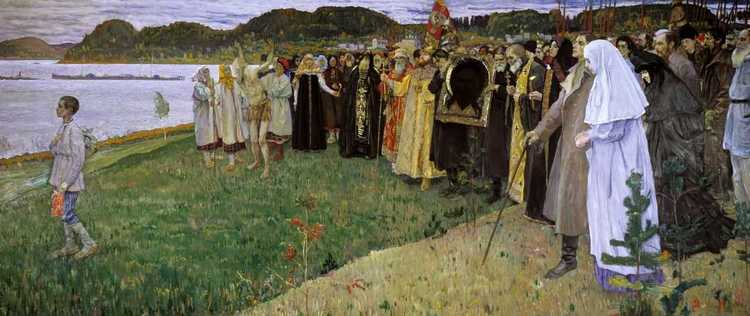
The working title of this painting by Nesterov was “Christians”, later it was called “In Russia” (Soul of the People). She completed her search for a monumental painting expressing the cherished Nesterov’s thoughts about Russia. Nesterov worked on this painting in the period between the first Russian revolution in 1905 and the first world war in 1914. It was finished at the height of the war and reflected the artist’s concern for the fate of his homeland. Nesterov tries to answer the questions: “Who are we? Where are we from? Where are we going? ”, The artist refuses to depict those who are toiling and burdened and shows Russia in all its spiritual and intellectual power. He does not introduce Christ into the picture, remembering about previous unsuccessful attempts, and maybe about the opinion of Leo Tolstoy, who considered this task impossible. Only in one of the initial sketches does a crowd of people follow Christ. In the picture, Christ is present only in the form of an ancient darkened icon of the Savior. On the right plane, attention is drawn to the “Bride of Christ” with a burning candle in her hand. On the left, there is a painting in a group of women in white canvas panels – “For Christ’s sake, the holy fool,” a man voluntarily assuming the guise of a madman in order to live by the law of truth.
In the painting “In Russia. The soul of the people “Christian writers Dostoevsky, Tolstoy, Vladimir Soloviev are walking along with the people. Nesterov especially admired Dostoevsky. Behind the figure of the writer, he placed his hero, the “Russian monk” Alyosha Karamazov.
In Tolstoy, he saw primarily a master of the word, but he was ironic about his Christian philosophies. “Christianity” for this, in essence, a nihilist, “mischievous thought” is an incomparable “theme”. Tolstoy is placed standing outside the crowd and as if in doubt – is it worth joining?
This whole crowd is moving along the banks of the Volga. Nesterov chose this river as the background of the painting, remembering the great role it played in the history of Russia. The landscape is concrete – it is the Volga at the Tsarev Kurgan, but it has an epic breadth.
Before the crowd, far ahead of her, there is a boy in a peasant dress with a knapsack over his shoulders and a painted bag in his hand. This is the semantic center of the picture. The artist wanted to say in the words of the Gospel: “You will not enter the kingdom of heaven until you are like children.” It is the child that turns out to be the most perfect expression of the soul of the people.
The painting was still in the studio when the February Revolution broke out. After her, the October Revolution thundered, and the Holy Russia of Nesterov left, never to return.
Year of painting: 1916.
Painting dimensions: 206 x 484 cm.
Material: canvas.
Writing technique: oil.
Genre: symbolic painting.
Style: symbolism.
Gallery: State Tretyakov Gallery, Moscow, Russia.